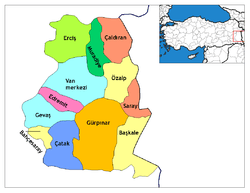Edremit, Van
This article is on the town and the district of Edremit in Van Province, eastern Turkey. For the town and the district of Edremit in Balıkesir Province, on the Aegean coast in western Turkey, see Edremit, Balıkesir.
| Edremit | |
|---|---|
 Edremit | |
| Coordinates: 38°25′27″N 43°15′22″E / 38.42417°N 43.25611°ECoordinates: 38°25′27″N 43°15′22″E / 38.42417°N 43.25611°E | |
| Country |
|
| Province | Van |
| Government | |
| • Mayor | Sevil Çetin (BDP) |
| • Kaymakam | Nurullah Ertaş |
| Area[1] | |
| • District | 270.27 km2 (104.35 sq mi) |
| Population (2012)[2] | |
| • Urban | 14,225 |
| • District | 26,218 |
| • District density | 97/km2 (250/sq mi) |
| Post code | 65170 |
| Website |
www |
Edremit (Kurdish: Ertemêtan) is a district of Van Province of Turkey. The district's center town of the same name is situated on the coast of the Lake Van at a distance of 18 kilometres (11 mi) from the city of Van.
Etymology
- The current name of Edremit originates from Armenian name of Artamet, which literally means "Near the Fields" in Armenian, as it lies near the fields of grape and apple trees at the coastline of lake Van. Also, Artamet deserved the title of the capital of Armenian apples, because during millennia Artamet's apples believed to be better in the whole Armenia.
- The Greek name for Edremit is Adramyttion (Άδραμύττιον). Greeks connect this name with the ancient Greek goddess Artemis.
- The Latin name is Adramyttium.
History
Artamet's foundation predates the Christian era. It was founded as a small town at the shores of Lake Van in Tosp district of Vaspurakan province lying in the middle of Historical Armenia. In the course of history, the city has had several names: Artemida, Zard, Artashessyan, Avan, Artavanyan and now - Edremit. In the 10th century Artamet was known as a feudal city with a population of 12 000. It was renowned for the best apples in all Armenia.
At the beginning of the 19th century Artamet had approximately 500 houses, 435 of which were Armenian, and 65 Turkish. After the first Armenian genocide of 1894–1896 the number of Turkish houses rose so quickly that the city consisting of 600 families has already 200 Armenian and 400 Turkish families.
On the edge of the Armenian genocide Armenians lived mainly in central part of Artamet, Turks settled near peripheral gardens and fields. Before 1915 Artamet had 10 Armenian churches and 1 Greek church. Armenians, Greeks, Assyrians and other local Christians were almost entirely destroyed by Turks in 1915-1923 Armenian genocide. After the legal owners were massacred, thousands of their historical monuments were annihilated as well.
Events of Artamet in 1915 are described in the book of Venezuelan writer Raphael de Nogales.[3]
References
- ↑ "Area of regions (including lakes), km²". Regional Statistics Database. Turkish Statistical Institute. 2002. Retrieved 2013-03-05.
- ↑ "Population of province/district centers and towns/villages by districts - 2012". Address Based Population Registration System (ABPRS) Database. Turkish Statistical Institute. Retrieved 2013-02-27.
- ↑ Four Years Beneath the Crescent
